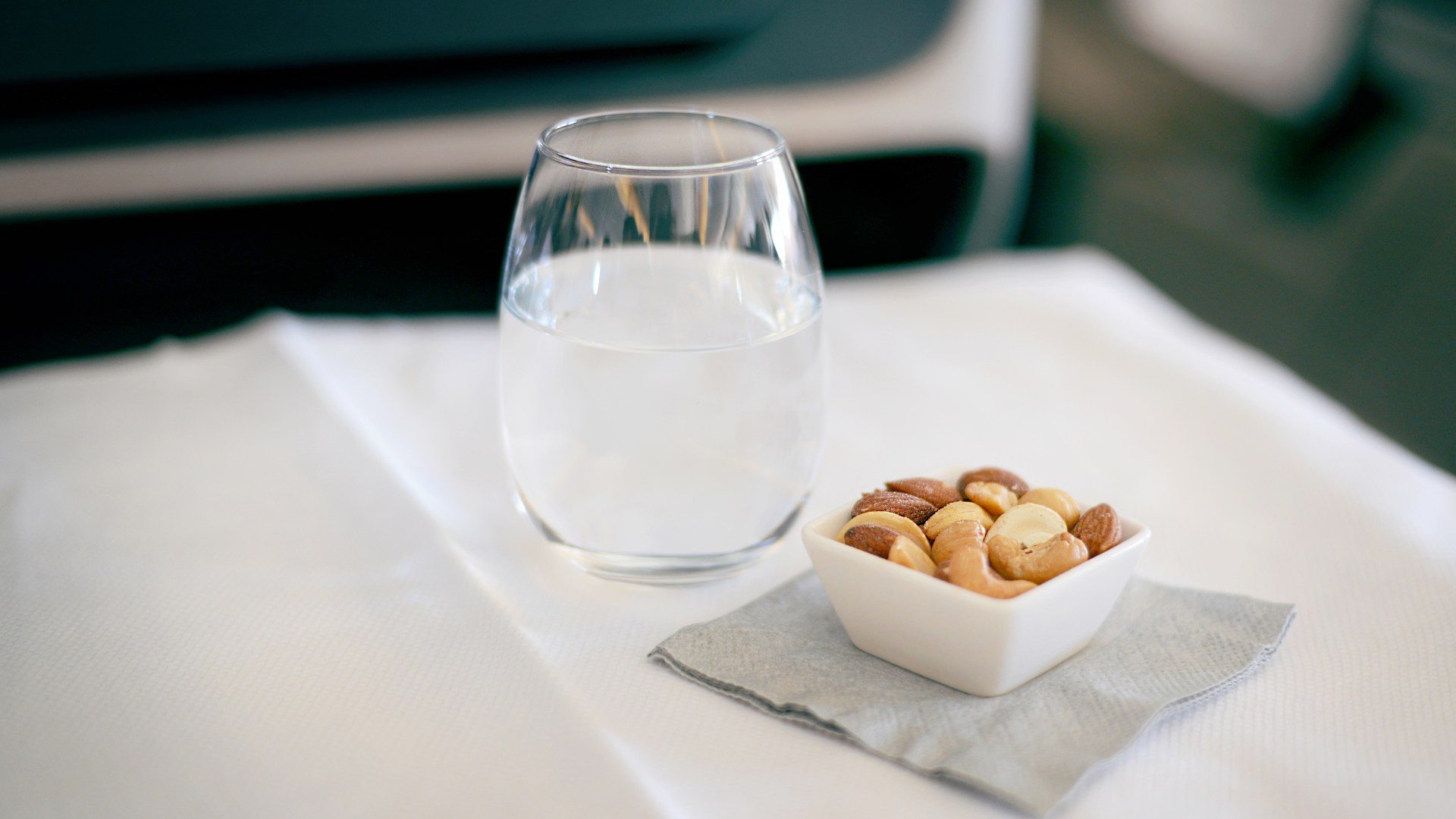THE idea that nut dust can become airborne and trigger deadly allergic reactions on planes has today been questioned by scientists.
There’s no evidence that allergens can be spread in the air through aircraft ventilation systems, allergy and aviation experts stated.
2

2
Sticky allergen residue lingering on seats, tray tables and video screens may in fact pose a greater risk of triggering allergic reactions, a review published in the Archives of Disease in Childhood warned.
“Allergenic food is really sticky, and can be found on seat surfaces, table tops, and seat-back entertainment screens,” Prof Paul Turner, clinical professor in anaphylaxis, paediatric allergy and clinical immunity at Imperial College London’s National Heart & Lung Institute, explained.
Fast turnaround times for many low-cost carriers may add to this risk, scientists suggest, as little cleaning is done in between flights.
But allergic reactions to foods are around 10 to 100 times less common during flights than they are ‘on the ground,’ they pointed out – though they acknowledged that this could be due to passengers with food allergies taking more precautions when flying.
Prof Turner stressed: “People shouldn’t be worried about what food is being transmitted in the air when they fly.
“We didn’t find any evidence that nut particles could travel through the cabin ventilation system on airplanes and cause reactions.
“On top of that, the vast majority of people with food allergies don’t react to the smell of food, even if they are allergic to very small amounts.”
Around 2–3 per cent of children and 1–2 per cent of adults in the UK have a food allergy, the most common cause of potentially life threatening allergic reactions known as anaphylaxis.
The reaction rapidly progress in the minutes after someone is exposed to a food or substance they’re allergic to, but it can also occur up to two or three hours later.
Characterised swelling in the throat and upper airways, wheezing, dizziness and confusion, anaphylaxis requires immediate emergency treatment.
It is widely believed that particles from foods can float through aircraft ventilation systems and trigger reactions in people with allergies.
To examine the issue, researchers were commissioned by the UK’s Civil Aviation Authority (CAA) to review evidence on the topic dating back to 1980.
They found that allergic reactions triggered by airborne particles are rare – with the exception vapours from fish and seafood and exposure to wheat flour in kitchens and baking and milling industries.
While peanut allergens can be detected at very low levels in the air after nuts are shelled, the dust settles quickly and can only be detected in very close proximity to the nuts.
This suggests that very little dust actually drift through the air.
What’s more, aircraft cabin ventilation systems are designed to circulate air across the aircraft, rather than along the cabin.
The study authors said this lowers the risk of spreading contaminants from passengers through the cabin.
Air is completely exchanged every three to four minutes during a flight, compared with every 10 minutes for hospitals and classrooms, they added.
The signs of an allergic reaction and anaphylaxis
SYMPTOMS of an allergy usually occur within minutes of contact with with the offending food or trigger, but they can also come on up to one hour later.
Most allergic reactions are mild but they can also be moderate or severe.
Anaphylaxis is the most severe form of allergic reaction which can be life threatening.
Mild to moderate symptoms include:
- Itchy mouth, tongue and throat
- Swelling of lips, around the eyes or face
- Red raised itchy rash (often called nettle rash, hives or urticaria)
- Vomiting, nausea, abdominal pain and diarrhoea
- Runny nose and sneezing
Severe symptoms of anaphylaxis include:
- Swelling of your throat and tongue
- Difficulty breathing or breathing very fast
- Difficulty swallowing, tightness in your throat or a hoarse voice
- Wheezing, coughing or noisy breathing
- Feeling tired or confused
- Feeling faint, dizzy or fainting
- Skin that feels cold to the touch
- Blue, grey or pale skin, lips or tongue – if you have brown or black skin, this may be easier to see on the palms of your hands or soles of your feet
Anaphylaxis and its symptoms should be treated as a medical emergency.
Follow these steps if you think you or someone you’re with is having an anaphylactic reaction:
- Use an adrenaline auto-injector (such as an EpiPen) if you have one – instructions are included on the side of the injector.
- Call 999 for an ambulance and say that you think you’re having an anaphylactic reaction.
- Lie down – you can raise your legs, and if you’re struggling to breathe, raise your shoulders or sit up slowly (if you’re pregnant, lie on your left side).
- If you have been stung by an insect, try to remove the sting if it’s still in the skin.
- If your symptoms have not improved after 5 minutes, use a 2nd adrenaline auto-injector.
Do not stand or walk at any time, even if you feel better.
Sources: Allergy UK, NHS
In modern large commercial aircraft, around half of the air is recirculated air that’s been passed through particulate air filters to remove dust, vapours and germs, and capture airborne food particles at the same time.
The other half comes from outside.
However, passengers may come into contact with allergens lingering seats, seat-back entertainment systems and tray tables, as food proteins are often “sticky”, researchers noted.
Allergy suffers touching these surfaces may transfer food particles into food they eat or directly on their mouths and faces by touching them.
How to protect yourself during a flight
Cleaning the surfaces at the start of a flight with sanitising wipes will minimise the risk of allergen exposure, researchers said.
This is “particularly important, given the minimal cabin cleaning which often occurs in between flights, especially with low-cost carriers,” they noted.
Allowing passengers with allergies to board the flight before others may be helpful, say the authors.
The US Department of Transportation already requires airlines to allow passengers with nut allergies to do this.
Prof Turner: “The one thing people must do to protect themselves is to clean their seat area.
“Allergenic food is really sticky, and can be found on seat surfaces, table tops, and seat-back entertainment screens.
“People touch these surfaces, and then the allergens can be transferred to their mouths.
WHAT ARE THE MOST COMMON FOOD ALLERGIES?
APPROXIMATELY 44 per cent of people in Britain have an allergy or allergic disorder of some kind, says the charity Allergy UK.
Rates are higher in under-35s and lowest in pensioners.
The most common food allergies, according to the NHS, are:
- Cow milk
- Eggs
- Peanuts
- Nuts, such as walnuts, almonds, hazelnuts, pecans, cashews, pistachios and Brazil nuts
- Soy beans, chickpeas and peas
- Shellfish
- Wheat
You may be allergic to a food if it makes you feel dizzy, lightheaded, sick or itchy, brings you out in hives or swollen lips or eyes, or causes diarrhoea, vomiting, a runny nose, cough, breathlessness or wheezing.
“If food-allergic people can board first, and have time to clean their seat area with something like a baby wipe or antibacterial wipe, they are much less likely to have accidental reactions.”
Announcements requesting passengers not to consume nuts during the flight are unlikely to reduce the risk of in-flight reactions and can give allergy sufferers a false sense of security, study authors added.
Passengers with food allergies often opt to bring their own food, but most airlines offer allergen-free options that can be requested in advance.
Meanwhile, people at risk of food anaphylaxis are advised to carry adrenaline auto-injectors, such as an EpiPen in their hand luggage, as these aren’t always included in onboard medical kits.
Study authors noted that in some cases cabin crew aren’t allowed to use them.
“Airlines should have clear policies relating to food allergies which are easily available from their websites or on request.
“These policies should be applied consistently by both ground staff and cabin crew, in order to provide reassurance to food-allergic passengers and their caregivers,” they added.
What’s next for allergy flight safety
Prof Turner said: “We’re having discussions with a number of major airlines as well as patient groups and anaphylaxis charities, to see if we can get some consistent changes in airline policy across airlines operating out of the UK and internationally, to reflect what the evidence is and really make a difference to food-allergic passengers.”
Simon Williams, chief executive of Anaphylaxis UK, commented: “A key take-home message is the importance of passengers cleaning their seat area, including the tray table and the seat-back entertainment system.”




